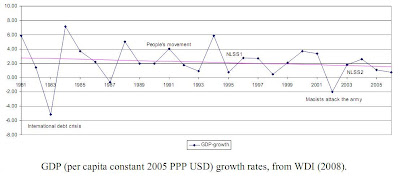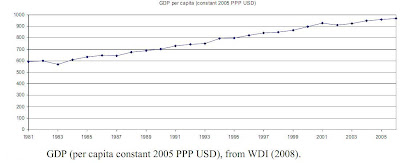Nepal, which has a per capita GDP of US $470 (2007/08), has witnessed impressive progress in poverty reduction in the last decade. According to NLSS II, the headcount poverty rate declined from 42% to 31% between 1995/96 and 2003/04, urban poverty declined from 22% to 10%, and rural poverty declined from 43% to 35%. However, income inequality is increasing: 6.4% per year for the richest 20%, as compared to 3.7% for the next quintile, and 2.5% for the lowest 20%.
The main four reasons for decrease in poverty level are remittances, farm wages, urbanization, and decline in fertility. But this decrease in poverty level is not uniform among all the population groups. Two factors that account for this are shift in structural employment and discrepancy in migration, according to a paper on inclusive growth in Nepal. This is a pretty different explanation as compared to the earlier standard explanations from the WB and government reports. This probably is true for regional reduction in poverty. Also, the author argues that he finds a strong relation between social exclusion, as defined by the caste system, and economic poverty.
The main pathways out of poverty from 1995 to 2003 have been landless farm workers who became subsistence farmers, construction or manufacturing workers, and subsistence farmers who added to their income by working in the same trades of construction and manufacturing industries, or as migrants to India.
The high poverty rates among the Tamang and Rai people of the eastern hills are reflected in the high average poverty rate of the eastern hills as reported in NLSS (2005). The eastern hills of Nepal is the only part of the country where the poverty rate increased from 1995 to 2003. This supports the conclusion that labor migration is a main explanation for the decline in poverty…. migration is at the lowest in the eastern hills, and if they migrate they tend to migrate within Nepal. In the western hills, on the other hand, a large majority migrate to India. The high level of labor migration to India from the western hills may explain the reduction in poverty in this region.
Can more households follow the same pathways out of poverty? The paper states that this (quite predictably) depends on the economic policy of the government. The author suggests that the government can learn from the experiences of successful Indian states like Kerela and Punjab. Meanwhile, for inclusive growth in sustainable agricultural sector and manufacturing sector hold the key to path out of poverty—for instance, employing Dalits and marginalized groups in manufacturing and construction business in semi-urban areas and freeing permanent laborers from landlords in villages and enacting moderate land distribution schemes, the author argues.
A combination of a social security net with competitive markets and secure property rights, may foster domestic and foreign investments in productive physical and human capital. The role of the government will be to broaden the tax base, and spend the tax incomes, as well as foreign aid, on public goods in support of the combined goal of social security and economic growth. This implies investments in roads, transmission lines for electricity, irrigation, as well as primary education and subsidized health services. Nepal may also consider to copy the rural employment guarantee of India. With a sound social and economic policy Nepal may in general be able to copy the developments of the most successful states of India, with a combination of the policies of Kerala and Punjab, where Kerala focused early on the social sectors, while Punjab focused on agriculture.

Note that the present government is run by the Maoists who have gained popular support on the back of land reforms and end to feudalism. But the question is how are they going to do land reforms with tempering market and individual incentives? Concerns of private appropriability is running high. I remain skeptical about land redistribution program because of the unclear policies of the Maoists in this regard. A Maoist land minister had to resign last month after he refused to refute and retune a land grab stint Maoists party cadres did on his leadership! My concerns about the land reforms under the red flag here.

Policy interventions for inclusive growth:
Education and training programs leads to improved human capital. Subsidized health services insure people against major risks, which, in turn, allow them to make profitable investments rather than investments that make them able to handle different types of risk. Investments in physical capital, like transmission lines, roads and irrigation is necessary for economic growth, and a broad-based tax system is necessary to finance these and other costs. Finally, some targeted programs may be beneficiary, such as land redistribution to landless Dalits in remote villages of terai, and experiments with a rural employment guarantee in the same areas.
More on poverty in Nepal here.